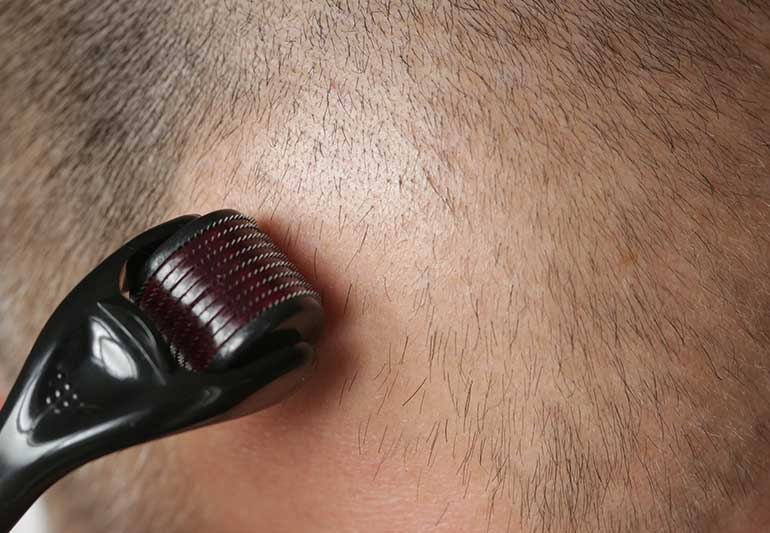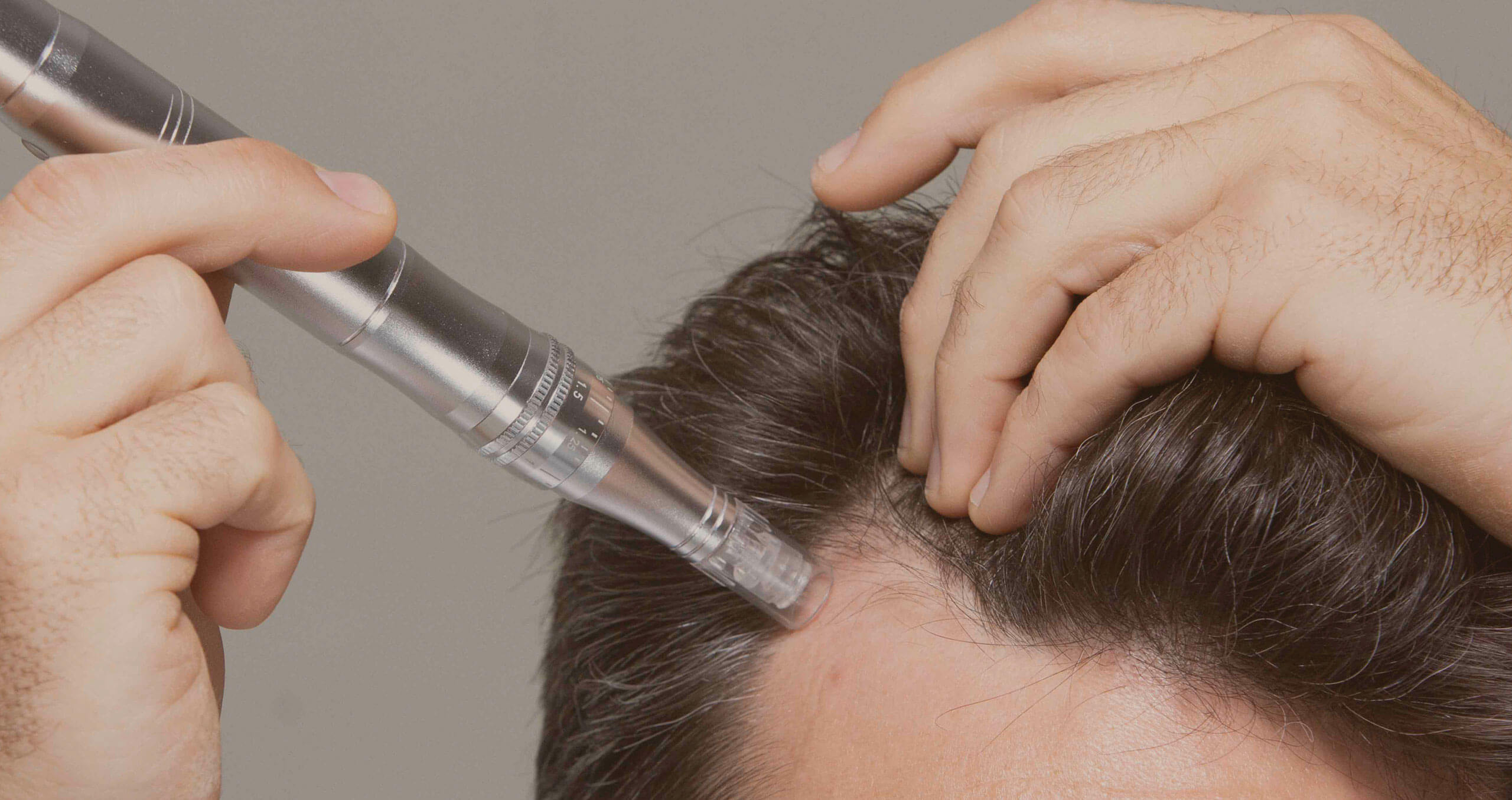Microneedling has garnered attention as a potential hair loss treatment. However, its effectiveness remains a debated topic. In this article, we will guide you on how to use microneedling effectively to combat hair loss. If you are uncertain about the timing of its application or wish to understand how it works to stimulate the healing process and hair growth. Keep reading!

WHAT IS MICRONEEDLING FOR HAIR LOSS?
In simple terms, microneedling is a hair loss treatment aimed at stimulating new hair growth on the scalp. This procedure uses a skin roller with tiny needles. It promotes increased collagen production in the skin. IInitially recognized for its scar treatment benefits in the 1990s, microneedling has since been explored as a potential standalone or supplementary therapy for androgenic alopecia and alopecia areata. When combined with platelet-rich plasma therapy (PRP hair treatment), microneedling becomes a highly effective treatment. It is particularly beneficial for addressing early symptoms of pattern hair loss, including male and female pattern baldness.
HOW DOES MICRONEEDLING FOR HAIR LOSS WORK?
Microneedling uses a handheld device, often called a roller. The device has needles that range from under 1 millimeter to a few millimeters in length. This device is carefully rolled across the treatment area, creating small controlled injuries. This process is believed to potentially initiate the release of growth-promoting factors or directly stimulate hair growth.
To enhance your comfort, we apply a topical anesthetic to your scalp about 45 minutes before the microneedling session. This ensures that any potential pain during the procedure is minimized. The actual microneedling procedure duration varies based on the size of the treatment area. It typically takes less than 10 minutes.
After completing the scalp microneedling, your healthcare provider may take additional steps to achieve the specific goals of the session. This could involve applying a topical balm to the treated area or administering an injection. The post-treatment measures are tailored to optimize the overall effectiveness and outcomes of the microneedling session.
HOW EFFECTIVE IS MICRONEEDLING AT PROMOTING HAIR GROWTH?
Researchers are still studying whether microneedling promotes hair growth. Some studies suggest positive results, but more robust evidence is needed to prove its effectiveness.
Several factors contribute to microneedling’s potential effectiveness:
- Microneedling stimulates the release of growth factors. These include platelet-derived growth factor (PDGF) and insulin-like growth factor (IGF-1). These growth factors play a role in stimulating hair follicles.
- The process enhances collagen production. This strengthens hair follicles and may improve hair quality.
- Improved Blood Flow: Increased blood flow to the scalp delivers essential nutrients and oxygen. This supports overall hair health.
- Temporary Channels for Absorption: Microneedling may create temporary channels in the skin. This may improve the absorption of topical hair loss treatments.
In 2018, researchers from the University of Maryland School of Medicine in the United States conducted this study. It focused on 41 men with androgenic alopecia, also known as male-pattern baldness. The participants were divided into two groups. One group received exclusive microneedling treatment. The other group received no treatment. The researchers observed participants for 12 weeks. They evaluated hair density using a dermoscope. The findings showed that the microneedling group had significantly more hair than the untreated group. To be precise, the microneedling group exhibited an average increase in hair density of 16.1%.
WHAT SHALL I EXPECT AFTER MY MICRONEEDLING TREATMENT FOR HAIR LOSS?
After microneedling treatment for hair loss, it’s normal to experience redness and mild swelling. Both should diminish within a few hours to a day. Pinpoint bleeding, another common occurrence, usually stops on its own. The tingling or prickling sensation induced by the needles is temporary and should subside shortly. In the following days, flaking or scabbing may occur as part of the healing process, resolving within a week. It’s crucial to resist picking at scabs to prevent potential scarring.
Looking ahead, the long-term results of microneedling are promising. Expect to see thicker and fuller hair, with optimal results manifesting around 3-6 months post-treatment. Some improvement in hair density and thickness may be noticeable as early as 4-8 weeks. Microneedling can stimulate hair follicles, promoting better hair growth. It may even slow down or reverse hair loss. Patience is key, and consistent follow-up sessions may be recommended for the best outcomes. Always follow the post-care instructions given by your microneedling professional. This will help you recover successfully and safely.
CAN I DO MICRONEEDLING AT HOME?
Despite the potential cost savings and convenience, at-home microneedling with derma rollers has notable drawbacks. Challenges include selecting the right needle size. It’s difficult to reach certain scalp areas. Proper technique is also at risk. Without professional guidance, users may struggle with timing, pressure, and the absence of adjuvant treatments. This reduces treatment effectiveness. For example, platelet-rich plasma might not be used. Licensed microneedling professionals enhance targeting precision and minimize side effects and complications. Buying a dermaroller may be tempting. However, safety and efficacy are best ensured under the expertise of trained professionals. Dermatologists strongly advise against at-home microneedling or seeking services from untrained providers.
WHAT ARE THE SIDE EFFECTS OF MICRONEEDLING ON THE HEAD?

Following microneedling, it’s crucial to distinguish between expected effects and potential concerns. The initial days after your treatment may include the following anticipated after effects:
BRUISING
Bruising in the treatment area following microneedling is normal and anticipated. It indicates the deliberate micro-injuries crafted to facilitate healing.This phenomenon occurs when microneedles are deliberately inserted into the skin. They trigger a cascade of physiological reactions that aim to start the healing process.
REDNESS
Redness is a normal and expected part of the body’s natural response to the tiny injuries caused by microneedling. This phenomenon occurs when microneedles penetrate the skin. This triggers a cascade of physiological reactions that aim to start the healing process.
OOZING FROM THE WOUNDS
Oozing from micro-injuries is a natural part of the body’s wound healing during microneedling. This process involves a controlled disruption of the skin’s surface, leading to the release of a small amount of fluid from the treated area.
SWELLING
SSwelling is a standard and expected reaction following microneedling. It shows the increased blood flow and nutrient delivery to the treated region. This response is a fundamental aspect of the body’s natural healing mechanism. It happens in response to the controlled micro-injuries induced by microneedling.
PAIN
Pain sensations are common after microneedling. They are in line with intentionally creating micro-injuries to achieve optimal results.The discomfort associated with microneedling is typically mild to moderate. It varies among individuals based on pain tolerance, skin sensitivity, and the depth of the microneedling procedure.
HOW MUCH IS MICRONEEDLING?
The cost for microneedling typically falls within the range of $200 to $700 per session when paying out of pocket. The size of the treatment area directly influences the overall expense. Larger areas generally result in higher session costs. Microneedling is often categorized as a cosmetic treatment. As a result, it is not typically covered by medical insurance.
CONCLUSION
Microneedling has shown some positive results. This is especially true when combined with other hair loss treatment methods. It addresses hair loss concerns and improves skin health. However, for a more thorough understanding and personalized treatment, it is advisable to consult with a doctor. They can provide detailed guidance on the most suitable treatment approach, based on individual needs and conditions.
FAQS
- Does microneedling reverse hair miniaturization?
Yes, Microneedling has shown promising results in potentially reversing hair miniaturization, contributing to improved hair thickness and health.
- How often should you microneedle for hair loss?
Microneedling should not be performed too frequently, as it carries the risk of scarring and can limit blood circulation to the treated area, leading to hair shedding. A recommended frequency is once per month, using a 1.5mm depth needle.
- Should I use minoxidil after microneedling?
Yes, topical Minoxidil should only be used on the scalp 24 hours after the micro-needling session, in order to avoid adverse side effects, such as scalp irritation.
- What is the success rate of microneedling minoxidil?
Results showed a 50% increase in hair regrowth in 80% of participants. So topical minoxidil and scalp micro needling may be effective in treating early cases of androgenetic alopecia.





